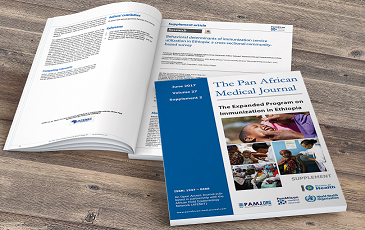Acquired hematometra post caesarean delivery: a case report
Lusajo Mwagobele, Rabson Bagoka, Lameck Mdengo, Godbless Kimaro Nelson, Frank Martin Sudai, Samson Vedastus, Emanuel Michael, Stanley Zakaria Binagi
Corresponding author: Lusajo Mwagobele, Department of Obstetrics and Gynaecology, Aga Khan University, Dar-es-Salaam, Tanzania 
Received: 18 Aug 2024 - Accepted: 06 Nov 2024 - Published: 21 May 2025
Domain: Radiology,Obstetrics and gynecology
Keywords: Hematometra, post-partum amenorrhea, caesarean delivery, case report
Funding: This research received no specific grant from any funding agency in the public, commercial, or not-for-profit sectors.
©Lusajo Mwagobele et al. PAMJ Clinical Medicine (ISSN: 2707-2797). This is an Open Access article distributed under the terms of the Creative Commons Attribution International 4.0 License (https://creativecommons.org/licenses/by/4.0/), which permits unrestricted use, distribution, and reproduction in any medium, provided the original work is properly cited.
Cite this article: Lusajo Mwagobele et al. Acquired hematometra post caesarean delivery: a case report. PAMJ Clinical Medicine. 2025;18:2. [doi: 10.11604/pamj-cm.2025.18.2.45046]
Available online at: https://www.clinical-medicine.panafrican-med-journal.com//content/article/18/2/full
Acquired hematometra post caesarean delivery: a case report
![]() Lusajo Mwagobele1,&, Rabson Bagoka2, Lameck Mdengo2, Godbless Kimaro Nelson2,
Lusajo Mwagobele1,&, Rabson Bagoka2, Lameck Mdengo2, Godbless Kimaro Nelson2, ![]() Frank Martin Sudai2,3, Samson Vedastus2, Emanuel Michael2, Stanley Zakaria Binagi2
Frank Martin Sudai2,3, Samson Vedastus2, Emanuel Michael2, Stanley Zakaria Binagi2
&Corresponding author
Hematometra, an abnormal buildup of blood within the uterus, is a seldom-seen issue often associated with congenital abnormalities or prior surgical procedures that result in blockage of the genitourinary outflow tract with a potential of endometriosis due to retrograde menstruation. We present case of a 38-year-old woman; parity 3, living 2 (P3L2) with a history of caesarean delivery due to intrauterine fetal demise and transverse presentation five years prior admission. The patient reported cyclic abdominal pain, mild distension, and amenorrhea post-caesarean delivery, undergoing three dilatation and curettage procedures during the course of her illness. Abdominal ultrasound and CT imaging confirmed the presence of hematometra, prompting a hysterectomy that revealed cervical stenosis. This case highlights a rare complication associated with caesarean delivery.
A hematometra refers to the accumulation of blood within the uterus usually because of a blockage in the lower part of the genital tract [1]. This blockage can result from congenital anomalies or scarring due to previous surgical interventions, such as caesarean deliveries which is considered uncommon with limited available data on its prevalence [2]. We report the case of a 38-year-old woman with a history of amenorrhea due to cervical stenosis after caesarean delivery; this condition was ultimately resolved through a successful hysterectomy.
Patient information: a 38-year-old female; parity 3, living 2 (P3L2) with a history of a previous transverse presentation caesarean section five years ago following intrauterine fetal death at 32 weeks gestation, presented with cyclic abdominal pain affecting alternating sides of the abdomen each month. She reported an absence of menstrual flow since the last caesarean section, without nausea, vomiting, or urinary symptoms. During the course of her illness, she underwent dilatation and curettage procedures at 8-month intervals, resulting in the removal of darkish blood and temporary symptom relief. However, the symptoms recurred. In her gynecological history, she attained menarche at 14 years, had regular 29-day menstrual cycles with a 3-day duration, using 3 pads per day partially soaked. Her past obstetric history includes an uneventful spontaneous vertex delivery of a male baby weighing 2.9 kg and a female baby weighing 3.0 kg, with no postpartum complications. In terms of family and social history, she is a peasant with no history of contraception use or medications.
Clinical findings: upon examination, the patient was alert, non-pale, and exhibited stable vital signs. She displayed tenderness upon palpation in the suprapubic region, with the uterus measuring approximately 8 cm from the pubic symphysis. During the speculum examination, the cervix was observed to lack a visible opening at the external os and was not protruding in its normal anatomical position. Instead, it was noted to be at the same level as the vaginal fornix.
Timeline of current episode: on July 2, 2024, the patient was evaluated in the outpatient gynecology clinic and subsequently admitted for an elective total abdominal hysterectomy on July 3, 2024. She was discharged on July 5, 2024.
Diagnostic assessment: the complete blood count revealed normal values (WBC 5.6, Hb 12.3 g/dL, Plt 200), with a negative urinary pregnancy test, blood group A positive, and normal serum creatinine levels. An abdominal-pelvic ultrasound demonstrated a uterus containing a significant amount of fluid, while a contrasted abdominal CT scan (Figure 1) revealed a notable collection of free fluid within the endometrial cavity measuring 4.16 x 2.73 x 2.71 cm, with no air bubbles present and no other abnormalities detected in the abdomen.
Diagnosis: acquired hematometra post caesarean delivery was established.
Therapeutic interventions: the patient underwent an elective total abdominal hysterectomy, during which an 8cm firm uterus was identified (Figure 2) and excised step-wisely. Intraoperatively, cervical stenosis at the isthmus (Figure 3) and a longitudinal resection of the anterior uterine wall revealed dark chocolate-colored blood (Figure 4) with the cervix stenosed (Figure 5) not extending significantly towards the vaginal wall, vaginal vault sutured after hysterectomy (Figure 6).
Follow-up and outcome of interventions: two weeks postoperatively, the patient presented at the outpatient gynecology clinic with a healed wound, alleviation of pain, and absence of any complications.
Patient perspective: “I am pleased that the issue was identified and following the procedure, I have not experienced any abdominal pain thereafter”.
Informed consent: the patient provided informed consent for the publication of this medical case in a medical article.
A hematometra refers to the accumulation of blood within the uterus, often resulting from gynatresia, which involves partial or complete blockage of any part of the lower genital tract [1]. The exact incidence and prevalence of hematometra post-caesarean delivery are not extensively documented in the literature. While uncommon, the development of intrauterine adhesions and hematometra/pyometra can be observed as long-term consequences following a caesarean section [3]. Hematometra can result from obstructions at the isthmus of the uterus, cervix, or vagina, with congenital causes including imperforate hymen and transverse vaginal septum, and acquired causes such as senile atrophy, scarring from procedures, and malignancies affecting the endocervical canal. Common acquired lower tract stenosis factors include senile atrophy, scarring from procedures like surgery or radiation therapy, and malignancies affecting the endocervical canal [4].
In the context of caesarean delivery, numerous risks have been documented in reported cases. These risks encompass the placement of multiple hemostatic sutures [5], manual removal of the placenta [6], suturing of both the anterior and posterior uterine walls [7], utilization of compression sutures [8], development of uterine synechiae and ventral fixation of the uterus to the abdominal wall following multiple caesarean deliveries [9]. In this case report, detailed intraoperative information regarding the caesarean section was not available, aside from the indication provided by the patient.
The clinical diagnosis of hematometra may be indicated by cyclic abdominal pain characterized by cramping in the midline or lower abdomen, coupled with the absence of menstrual blood flow. Upon examination, the uterus may exhibit a firm and mildly enlarged feel, as documented in this case report. Imaging techniques such as transabdominal or transvaginal ultrasound are typically employed as the initial diagnostic modality. Ultrasound imaging reveals a distended endometrial cavity filled with turbid fluid material showing low-level echoes up to the level of obstruction, along with a stretched myometrium. Additional imaging modalities, such as abdominopelvic CT scan or Magnetic Resonance Imaging (MRI), may be utilized to evaluate uterine anatomy and the extent of obstruction. These imaging methods also offer insights into any associated changes, such as hematosalpinx [1,4,10].
Hematometra is typically managed through surgical cervical dilation to evacuate the blood from the uterus [2]. Additional treatments focus on addressing the root cause of hematometra; for instance, a hysteroscopy may be necessary to remove adhesions that have formed post-surgery [4]. In this case described, the patient opted for a hysterectomy after undergoing three dilatation and curettage procedures and experiencing a recurrence of symptoms. Complications associated hematometra can include but no limited to pelvic infections such as tubo-ovarian abscesses, obstructive acute renal failure, peritonitis, endometriosis, hematosalpinx, and constipation [4].
We reported the case of a 38-year-old woman who developed amenorrhea due to cervical stenosis after a cesarean section, resulting in blood accumulation in the uterus; this condition was ultimately resolved through a successful hysterectomy. This case highlights the rare but important complication of hematometra after a caesarean delivery, emphasizing the importance of thorough and prolonged monitoring of postoperative patients to address potential complications that may arise.
The authors declare no competing interests.
Patient management: Lusajo Mwagobele, Rabson Bagoka, Lameck Mdengo, Emmanuel Michael and Samson Vedastus. Data collection: Lusajo Mwagobele. Manuscript drafting: Lusajo Mwagobele. Manuscript revision: Lusajo Mwagobele, Frank Martin Sudai, Lameck Mdengo, Godbless Kimaro Nelson, Rabson Bagoka and Stanley Zakaria Binagi. All authors read and approved final version of the manuscript.
The authors express gratitude to the patient for consenting to the sharing of her medical history for publication, intended for educational purposes.
Figure 1: abdominopelvic CT scan: A) uterus; B) collection of fluid in endometrial cavity
Figure 2: intraoperatively: A) body of uterus; B) right ovary; C) left ovary; D) cervix
Figure 3: after hysterectomy showing uterus, inflamed fallopian tubes and A: stenosed cervix with fibrous
Figure 4: longitudinal resection of the uterus showing chocolate collection of blood
Figure 5: A) stenosed cervix
Figure 6: A) vaginal vault sutured after hysterectomy
- McGlinn JA, Harer WB. Hematometra. Am J Obstet Gynecol. 1935;30(5):704-709.
- Kaur G, Jain S, Sharma A, Vaid NB. Hematometra formation-A rare complication of cesarean delivery. Journal of Clinical and Diagnostic Research: JCDR. 2014 Aug 20;8(8):OD03. PubMed | Google Scholar
- Ochoa M, Allaire AD, Stitely ML. Pyometria after hemostatic square suture technique. Obstet Gynecol. 2002;99(3):506-509. PubMed | Google Scholar
- Clinical Gate. Hematometra and Hematocolpos. 2015. Accessed on July 27, 2024.
- Poothavelil MB, Hamdi I, Zunjurwad G. Occlusion of upper genital tract following lower segment caesarean section for placenta praevia. Sultan Qaboos Univ Med J. 2008;8(2):215-218. PubMed | Google Scholar
- Golan A, Raziel A, Pansky M, Bukovsky I. Manual removal of the placenta--its role in intrauterine adhesion formation. Int J Fertil Menopausal Stud. 1996;41(5):450-451. PubMed | Google Scholar
- Saeed GA. Case of postoperative haematometra in a 40-year-old woman. East Mediterr Health J. 2010 Feb;16(2):237-9. PubMed | Google Scholar
- Dadhwal V, Sumana G, Mittal S. Hematometra following uterine compression sutures. Int J Gynaecol Obstet. 2007 Dec;99(3):255-6. PubMed | Google Scholar
- Mathelier AC. Unusual late complications after two previous cesarean deliveries: a case report. Int J Fertil Womens Med. 2003;48(2):70-73. PubMed | Google Scholar
- Weerakkody Y. Haematometrium. Radiopaedia. 2021.











